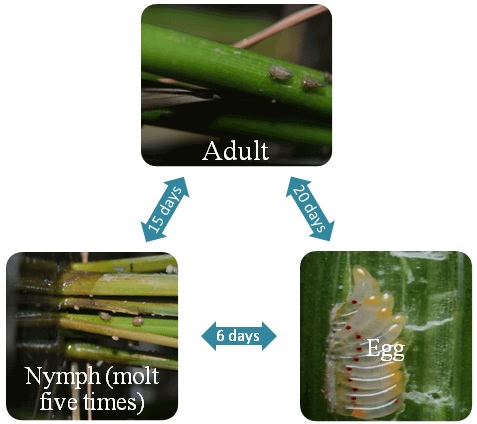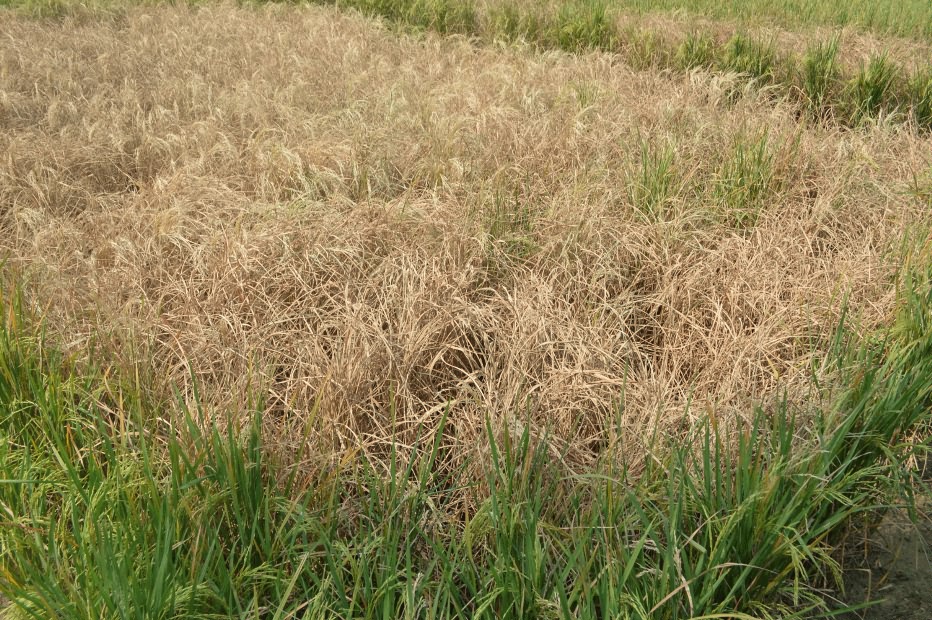चावल पारिस्थितिक तंत्र का विध्वंसक कीट - ब्राउन प्लांटहोपर
Rice is a primary staple food crop for billions of people worldwide. To ensure global food security for continuing population growth, it is vital to control the various insect pests that damage rice (Normile, 2008).
Among the herbivorous insects, Brown Planthopper (BPH), Nilaparvata lugens (Stal) to be considered as the devastating pest of rice, causing much distress among rice growers in the tropics, thereby posing serious threat to the national food security.
Both nymphs and adults of brown planthopper are mostly found at the base of the tillers, where shade and humidity is high, providing suitable microclimate for their multiplication. It can reduce the yield upto 80% depending on the degree of infestation.
Direct sown fields are more prone to heavy damage than transplanted fields. A hemipteran pest exhibiting incomplete metamorphosis with following stages
Egg: White colour banana or crescent shaped egg which is 0.99 mm long.
Nymph: Body is creamy white with a pale brown ting and has a prominent median line from the base of the vertex to metathorax.
Adult: Brown coloured body and chestnut brown eyes. Adults measures about 2.5-3.0 mm long can exist in two physical forms, long-winged (macropterous) and short-winged (brachypterous). The legs are hairless and the hind leg has a large, mobile tibial spur.
Life cycle (Fig. 1)

Fig. 1 Life cycle of BPH
Nature of damage caused by Brown plant Hopper
All plant growth stages are attacked, but the most susceptible growth stages are from early tillering to flowering. Nymphs and adults congregate at the base of the plant above the water level and suck the sap from the tiller. The affected plant dries up and gives a scorched appearance called “hopper burn” (Fig.2).
Circular patches of drying and lodging of matured plant are typical symptoms caused by this pest. The patches of infestation then spread out and cover the entire field. Honeydew excreted on infested plants act as the medium for development of sooty mould fungus. It also acts as a vector of grassy stunt, ragged stunt and wilted stunt viral diseases.

Fig. 2 Paddy field affected by BPH showing ‘Hopper burn” symptom
Economic threshold level
- 1 number/tiller; 2 numbers when spider is present at 1 number/hill
- Factors Contributing for BPH Multiplication in field
- Increasing nitrogen levels
- Closer plant spacing (15 X 10 cm)
- Higher alternative humidity
- Indiscriminate use of insecticides (Because Insecticides kill their predators and the parasitoids)
- Continuous submerged condition in the field
Integrated Pest Management of BPH
- Use resistant varieties like Aruna, Kanaka, karthika, Krishnaveni, Makon, Co 42, Ptb 21, Ptb 33, Abhey, Asha, Divya, PY 3, Manasarovar, Mekom, Nagarjuna, Neela, Annanga , Pavizham, Pratibha, Rashmi, Remya, Sonasali, Vajram , and Vijetha, IR26, IR64, IR36, IR56 and IR72.
- Avoid close planting and providing 30 cm rough spacing at every 2.5 m to reduce the pest incidence.
- Crop rotation with non-rice crops to avoid continuous supply of food to the insect.
- Avoid use of excessive nitrogenous fertilizer.
- Control irrigation by intermittent draining.
- Alternate wetting and drying the field during peak infestation.
- Set up light trap to monitor pest population and to control.
- Release of natural enemies like Lycosa pseudoannulata, Cyrtorhinus lividipennis (200-250 bugs/ha) during the peak incidence of brown planthopper at 10 days interval.
- Pandora delphacis is an entomophthoralean fungus,available in WP has the potency to killing the rice BPH extensively.
- Avoid use of insecticides causing resurgence such as synthetic pyrethroids, methyl parathion, fenthion and quinolphos.
- Spray neem seed kernel extract 5% (25 kg/ha) or Neem oil 2% (10 l/ha).
- Spray imidacloprid 17.8 SL 125 ml or buprofezin 25 SC 325 ml or acephate 75 SP 625 g/ha.
Reference:
- Normile, D. 2008. Reinventing rice to feed the world. Science, 321: 330-333.
- Rice Handout Series.www.pinoyrkb.com
- TnauAgri portal.http://agritech.tnau.ac.in/
- Rice Knowledge Management Portal. DRR, Hyderabad.
Authors:
*Guru PirasannaPandi, G., Soumia, P. S., Basana Gowda, G., Totan Adak and Mayabini Jena
Scientists, ICAR-National Rice Research Institute, New Delhi-110012
*e-mail :
